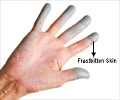Diagnosis
Scleroderma diagnosis is rather difficult as the symptoms of the disease overlap with those of other conditions. Therefore, it becomes necessary to rule out other auto immune diseases before focusing on scleroderma.
There are no clear -cut methods to diagnose scleroderma. The doctor would initially check the patient’s medical history after which a physical exam is conducted to:-
- Check the skin for hardness
- Examine the tendons and joints
- Examine the finger nails under a microscope to check for abnormal changes in blood capillaries
Blood tests are carried out to look for the presence of anti-nuclear antibodies (ANA).
The following are the ANAs whose presence could also indicate scleroderma:-
- Anti-single stranded DNA, rheumatoid factor and anti – histone antibodies are scleroderma - associated auto antibodies. It must be noted that these antibodies attack the genetic material within the nucleus. But they are not exclusive to the condition and are also linked to other autoimmune diseases such as lupus and rheumatoid arthritis
- Anti-RNA polymerase III, anti-topo-isomerase I and anti-centromere antibodies (ACA) are auto antibodies that are raised against nuclear enzymes involved in DNA and RNA production. However, these auto antibodies are found only in systemic scleroderma and not in the localized type
- Fibrillin is a protein found in muscles and connective tissues. Increased levels of anti-fibrillin 1 is observed in patients with both the types of scleroderma-localized and systemic. This antibody is exclusive to scleroderma and not to other auto immune diseases.
Lung complication diagnosis
- Examining with a stethescope to study the breathing pattern
- Lung Function Test to find out the lung capacity
- Examining sputum cells
- Lung X-ray
- Inhaling a chemical technetium-labeled diethylenetriamine penta acetate (99mTC-DTPA), to detect lung damage
- CT scans to check for lung scarring
Heart complications / pulmonary hypertension diagnosis
- Electrocardiography (ECG) to check the heart's electrical activity
- Echocardiography to detect an error in the beating heart
- Radionucleotide ventriculography: checks heart function using a radio active dye
GI complications diagnosis
- Endoscopy - an invasive procedure in which a tube with a small camera is inserted down the esophagus to detect gastrointestinal problems
- Manometry - to measure the pressure exerted by the esophagal muscle
- Electrogastrography (EGG) -evaluates the electrical activity in the stomach muscles












